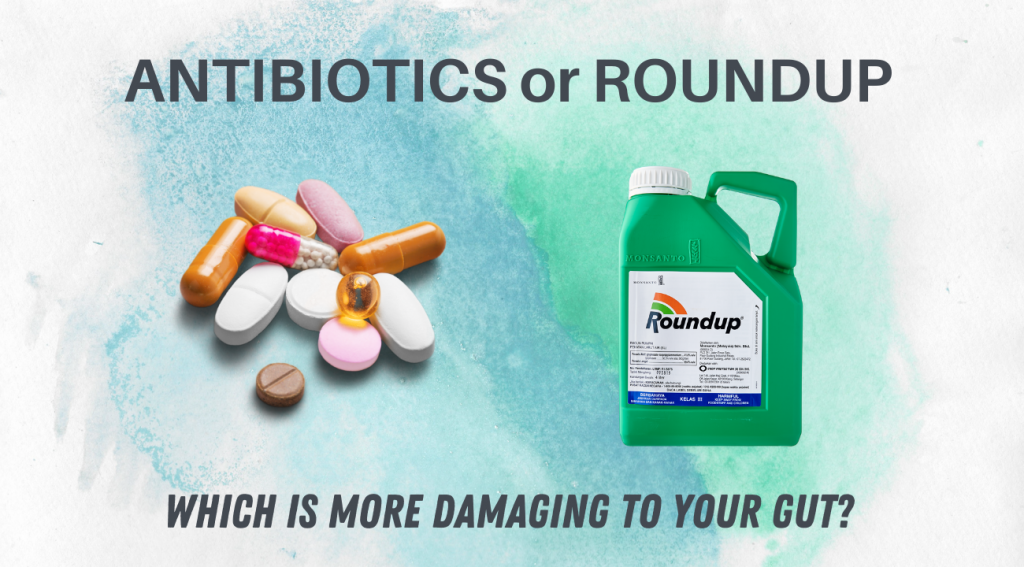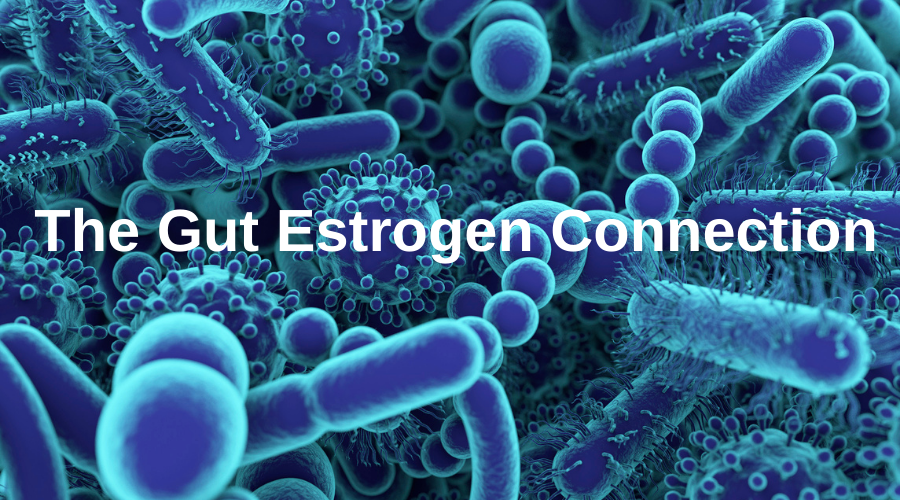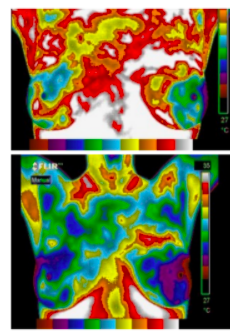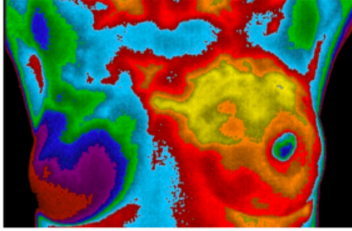
by Susan Brady | Jan 30, 2022 | Digestion

By now you know that your gut houses trillions of microorganisms. Most of these microorganisms are beneficial to our health. They aid in digestion, vitamin production, regulation of the immune system and inflammation, regulation of bone metabolism, and production of neurotransmitters that affect our mood and brain health. Among this community of microorganisms, there are also opportunistic bacteria and yeast. In small numbers, these so-called “bad” microorganisms are harmless. However, if they overgrow and start to overpopulate the gut microbiota it can lead to dysbiosis, inflammation, and associated disease conditions. By nourishing and supporting the beneficial bacteria, their abundance will naturally crowd out and prevent the overgrowth of opportunistic organisms. It is when the beneficial bacteria become compromised, that the opportunistic organisms will overgrow and start to dominate the gut.
It is well known that antibiotics can affect this critical balance of organisms in our gut microbiota. But so can numerous other things, including the herbicides used when farming our food.
Which do you think is more likely to damage your gut bacteria? Antibiotics or consuming foods that have been sprayed with the weed killer known as Roundup?
You might be surprised to learn that even though antibiotics can certainly have a negative effect on the gut microbiota, consuming conventionally grown foods sprayed with Roundup can actually be more damaging.
Here’s Why:
Antibiotics kill off ALL bacteria. When you take an antibiotic it not only targets the bacteria that is causing your infection, but also the bacteria in the gut microbiome. Antibiotics don’t discriminate, they eradicate the beneficial bacteria as well as the opportunistic bacteria.
Roundup works differently. The main ingredient in Roundup is a chemical called glyphosate. When glyphosate was originally developed by Monsanto in the 1970’s it was patented as an herbicide. However, it was then discovered to also have antimicrobial properties and Monsanto was later awarded a patent for glyphosate as an antibiotic. The antibiotic property of glyphosate is one of the primary ways it kills off the weeds and unwanted plant life. However, glyphosate is selective in the bacteria that it kills. Research indicates that glyphosate appears to preferentially kill off beneficial bacteria, like bifidobacterium and lactobacilli, allowing for an overgrowth of opportunistic bacteria. Bifidobacteria and lactobacilli are two of the most important bacteria for plant health and human health.
So unlike antibiotics that kill off both the beneficial and opportunistic bacteria, glyphosate, the primary ingredient in Roundup targets the beneficial bacteria while allowing the opportunistic bacteria to flourish.
Roundup has been the most widely used herbicide in the United States since 2001. Not only is it sprayed on the plants that we directly eat but also on the crops that our livestock eat. In animals such as pigs, cows, chickens, the glyphosate accumulates in the flesh that we then consume. In particular, it gets concentrated in the collagen of animals. Getting more collagen in our diets is the number one reason why we consume bone broth! Research has confirmed that glyphosates alter the gut microbiota of animals and there is growing evidence that it also disrupts our human microbiota. Until glyphosates are banned in the US, as they have been in many EU countries, for the sake of your gut, avoid them as best you can.
How to avoid glyphosates?
- Try to eat organically as much as possible to minimize exposure to Roundup and other herbicides whose primary ingredient is glyphosate. Foods most heavily sprayed with glyphosates are:
- soy, wheat, rice, corn, almonds, apples, apricots, asparagus, cherries, and dates
- Avoid genetically modified foods. GMO foods are plant or meat products that have had their DNA altered in a laboratory. Most GMO foods grown in the US are “Roundup Ready,” meaning they can withstand spraying of Monsanto’s Roundup pesticide and live, while weeds around it die. In turn, GMO foods can have a higher residue of glyphosates.
- Look for labels. Besides looking for USDA Organic labels, also look for labels such as NON GMO Project Verified label and the newest Glyphosate Residue Free labeling.

 .
. 
We have known for many years that antibiotics can damage gut microbiota. However, if you have to take an antibiotic to overcome an infection, it is generally only for a short period of time. Eating prebiotic and probiotic-rich foods and/or taking a probiotic supplement after taking an antibiotic can help to re-establish a healthy gut microbiota. Unfortunately, if you are not careful about what you eat, you can be exposed to glyphosates on a daily basis causing an ongoing and unrelenting assault on those precious bacteria that make up our gut microbiome. Even a probiotic with billions of bacteria will have difficulty maintaining a healthy gut microbiome under a constant barrage of glyphosates.
If you want to take a deeper dive into all the ways the gut and your digestion affect the health of your bones, please check out my free webinar “Is your gut holding your bones hostage”. Click here to go to the webinar.
Please reach out if you have any questions or would like to schedule a consult to talk about how to get your gut healthy!
703-738-4230
susan@nurturedbones.com
References:
- Aitbali, Yassine, Saadia Ba-M’hamed, Najoua Elhidar, Ahmed Nafis, Nabila Soraa, and Mohamed Bennis. “Glyphosate Based- Herbicide Exposure Affects Gut Microbiota, Anxiety and Depression-like Behaviors in Mice.” Neurotoxicology and Teratology 67 (June 2018): 44–49. https://doi.org/10.1016/j.ntt.2018.04.002.
- Barnett, Jacqueline A., and Deanna L. Gibson. “Separating the Empirical Wheat From the Pseudoscientific Chaff: A Critical Review of the Literature Surrounding Glyphosate, Dysbiosis and Wheat-Sensitivity.” Frontiers in Microbiology 11 (2020). https://www.frontiersin.org/article/10.3389/fmicb.2020.556729.
- Bruggen, A. H. C. van, M. R. Finckh, M. He, C. J. Ritsema, P. Harkes, D. Knuth, and V. Geissen. “Indirect Effects of the Herbicide Glyphosate on Plant, Animal and Human Health Through Its Effects on Microbial Communities.” Frontiers in Environmental Science 9 (2021). https://www.frontiersin.org/article/10.3389/fenvs.2021.763917.
- “Frontiers | Separating the Empirical Wheat From the Pseudoscientific Chaff: A Critical Review of the Literature Surrounding Glyphosate, Dysbiosis and Wheat-Sensitivity | Microbiology.” Accessed January 23, 2022. https://www.frontiersin.org/articles/10.3389/fmicb.2020.556729/full.
- ĀTA – Simply Better. “Glyphosate: What It Is and Why You Should Be Concerned,” February 4, 2019. https://ata.land/glyphosate-the-big-issue/.
- Hu, Jianzhong, Corina Lesseur, Yu Miao, Fabiana Manservisi, Simona Panzacchi, Daniele Mandrioli, Fiorella Belpoggi, Jia Chen, and Lauren Petrick. “Low-Dose Exposure of Glyphosate-Based Herbicides Disrupt the Urine Metabolome and Its Interaction with Gut Microbiota.” Scientific Reports 11, no. 1 (February 5, 2021): 3265. https://doi.org/10.1038/s41598-021-82552-2.
- Mao, Qixing, Fabiana Manservisi, Simona Panzacchi, Daniele Mandrioli, Ilaria Menghetti, Andrea Vornoli, Luciano Bua, et al. “The Ramazzini Institute 13-Week Pilot Study on Glyphosate and Roundup Administered at Human-Equivalent Dose to Sprague Dawley Rats: Effects on the Microbiome.” Environmental Health: A Global Access Science Source 17, no. 1 (May 29, 2018): 50. https://doi.org/10.1186/s12940-018-0394-x.
- Mesnage, Robin, Maxime Teixeira, Daniele Mandrioli, Laura Falcioni, Quinten Raymond Ducarmon, Romy Daniëlle Zwittink, Francesca Mazzacuva, et al. “Use of Shotgun Metagenomics and Metabolomics to Evaluate the Impact of Glyphosate or Roundup MON 52276 on the Gut Microbiota and Serum Metabolome of Sprague-Dawley Rats.” Environmental Health Perspectives 129, no. 1 (January 2021): 17005. https://doi.org/10.1289/EHP6990.
- Motta, Erick V. S., Kasie Raymann, and Nancy A. Moran. “Glyphosate Perturbs the Gut Microbiota of Honey Bees.” Proceedings of the National Academy of Sciences of the United States of America 115, no. 41 (October 9, 2018): 10305–10. https://doi.org/10.1073/pnas.1803880115.

by Susan Brady | Jan 14, 2022 | Nutrition

When you hear the word Osteoporosis, what’s the first food that comes to mind? Dairy. For years it has been drilled into us to eat more dairy and drink more milk to protect our bones. However, I disagree. In my opinion vegetables and fruits are the most important foods for building strong, healthy bones.
Certainly, dairy products like milk, cheese, and yogurt are a great source of calcium. Calcium is important for bone health, but our bones need so much more than just calcium to keep them strong, and calcium alone is not enough. Our bones need over 20 different nutrients for proper bone metabolism and there is increasing evidence that vegetables and fruits support our bones in ways that dairy doesn’t.
-
A 2015 study published in the journal Nutrients showed an increase in fruits and vegetables had a positive effect on bone health by reducing bone turnover and urinary calcium loss in post-menopausal women.
-
A 2016 study published in the Journal Bone MIneral Reserach showed that consuming less than 5 servings of fruits and vegetables a day was associated with a high risk of fractures, particularly in older women.
-
A 2021 study published in the Journal of Nutrition showed that a diet with a greater intake of vegetables was associated with improved bone metabolism, a decrease in bone resorption, and reduced loss of acid and calcium in the urine.
There are several mechanisms through which vegetables and fruits have a positive effect on bone health.
1. Vegetables and fruits contain many of the essential nutrients, beyond calcium, that our bones need to stay healthy. Dark leafy green vegetables in particular (think spinach, kale, etc.) are a rich source of minerals, not only calcium but also magnesium, zinc, manganese, copper, and potassium. Many different fruits and vegetables are great sources of important bone health vitamins such as vitamin A, C, and K.
2. Vegetables and fruits are rich sources of polyphenols, flavonoids, and carotenoids. All of these plant compounds have antioxidant and anti-inflammatory properties. Many diseases have been linked to oxidative stress and inflammation, including osteoporosis. These plant compounds can protect our bones from oxidation and inflammation that can stimulate excessive bone loss.
3. Vegetables and fruits can help balance out acid in the body and reduce the loss of calcium in the urine. Foods such as meat, poultry, dairy, eggs, and wheat are all considered to be acidic foods that can stimulate osteoclasts (cells that break down bone) leading to calcium loss in the urine and increased risk of bone loss. Because vegetables and fruits are alkaline-rich foods, they help to balance out and decrease the dietary acid load from other foods and reduce urinary calcium excretion and bone loss.
4. Vegetables and fruits support a healthy gut microbiome. Foods high in fiber like vegetables and fruits supply prebiotic fibers that nourish our gut microbes and allow them to thrive. They have also been shown to improve the diversity of bacteria in our gut. A greater diversity of bacteria in the gut microbiome is directly correlated with gut and overall health and well-being. Gut microbes can increase bone mass and improve osteoporosis by inhibiting osteoclast and promoting osteoblasts (bone-building cells).
I generally recommend that people aim to get 7-10 servings of vegetables and fruits a day, with twice as many vegetables as fruits. I know the idea of getting this quantity in a single day may sound a little overwhelming, but I promise you that it is actually easier than you think!
A serving size of most vegetables and fruits is only a 1/2 cup. A serving size of leafy greens is a cup.
If you are having a bowl of fruit in the morning with your breakfast you are most likely getting 2 servings of fruit. A large salad at lunch with 2 cups of leafy greens, 1/2 cup each of peppers, cucumbers, and tomatoes will give you another 5 servings. So before you even sit down for dinner, you have already had 7 servings and it should be easy to get another 2-3 servings in at dinner.
Still overwhelmed? Here are 3 simple tips you can follow:
1. Strive to get fruits and/or vegetables with every meal of the day.
2. Make vegetables and fruits the focus of every meal. When you are dishing out your plate, make 1/2 of your plate vegetables and/or fruits, 1/4 of your plate protein, and 1/4 of your plate complex carbohydrates like grains or legumes. Not only will this ensure you get your daily dose of fruits and vegetables but will also provide you with a healthy and well-rounded meal.
3. Change your thinking. Instead of thinking about “what should we have with our chicken/fish/lentils for dinner,” think “what should we have with our broccoli/cauliflower/greens/beets for dinner.” Build your meal around the vegetables instead of the protein.
For the longest time we have been so focused on consuming dairy for bone health. However, it is becoming increasingly evident that vegetables and fruits are just as important and arguably maybe even more important than dairy for maintaining bone health.
So, move over dairy there is a new food in town for building strong, healthy bones!
If you have any questions or need help putting together and bone-building diet, please reach out. I am always happy to help you build strong, healthy bones.
Contact me at: susan@nurturedbones.com or 703-738-4230
References:
1. Increased Intake of Selected Vegetables, Herbs and Fruits may Reduce Bone Turnover in Post-Menopausal Women
2. Fruit and Vegetable Intake and Hip Fracture Incidence in Older Men and Women: The CHANCES Project
3. Increasing Vegetable Intake Decreases Urinary Acidity and Bone Resorption Marker in Overweight and Obese Adults: An 8-Week Randomized Controlled Trial

by Susan Brady | Oct 28, 2021 | Healthy aging
Estrogen is what makes a woman uniquely female. It’s a critical hormone not only for reproduction but also for the health of your skin, brain, heart, gut, and bones. In fact, every one of these tissues has estrogen receptors that depend on estrogen to function properly.
But here’s the problem: our modern world is full of chemicals that mimic estrogen — and they can disrupt the way your hormones are supposed to work.
These chemicals are called xenoestrogens — artificial estrogens found in everyday products. When they bind to estrogen receptors in your body, they interfere with your natural hormones. Over time, this disrupts your endocrine system and creates a ripple effect on your health.
And yes, that includes your bones.
How Xenoestrogens Harm Your Bones (and More)
-
They interfere with bone remodeling, accelerating bone loss and increasing fracture risk.
-
They raise your risk of hormone-related cancers (breast, uterine, ovarian, prostate).
-
They contribute to conditions like hypothyroidism, weight gain, memory problems, diabetes, and neurological issues.
Where Are They Hiding?
You’re probably being exposed to xenoestrogens every single day. They’re in:
-
Plastics (water bottles, food containers, cling wrap)
-
Personal care products (lotions, soaps, shampoos, makeup, sunscreen)
-
Cleaning products and pesticides
-
Nonstick cookware and food packaging
-
Canned foods (from BPA in linings and coatings)
-
Conventional produce sprayed with pesticides
These chemicals build up in fat tissue and can linger in your body for years.
What You Can Do Right Now
The goal isn’t perfection — it’s minimizing exposure wherever possible. Small changes add up.
-
Swap plastics for glass or stainless steel.
-
Avoid microwaving food in plastic.
-
Look for chemical-free cleaning and personal care products.
-
Buy organic when you can, especially produce.
-
Eat more cruciferous vegetables (broccoli, cabbage, Brussels sprouts, cauliflower) to help detoxify these chemicals.
-
Support your gut health, which plays a major role in eliminating toxins.
These simple shifts can go a long way in protecting your hormones — and by extension, your bones.
The Bigger Picture
Toxins are just one piece of the bone health puzzle. Inflammation, gut health, stress, sleep, and diet all interact with your hormones to determine whether your bones are breaking down or rebuilding.
That’s why I’m inviting you to join me for my free webinar:
Rebuild & Restore Your Bones: Discover the Root Causes of Bone Loss—And How to Reverse Them Naturally
Thursday, September 11
Reserve your spot by clicking here!
We’ll uncover the hidden drivers of bone loss your doctor may not be testing for — and I’ll share natural steps you can start right away to rebuild and restore your bones.

by Susan Brady | Oct 21, 2021 | Digestion

Estrogen plays a vital role in women’s health. It is obviously very important in our reproductive health and our fertility but also plays a vital role in cognitive health, bone health, and heart health. However, excessive estrogen, especially in post-menopausal women, can contribute to estrogen-related cancers such as breast and ovarian cancer. So like with everything else in life, balance is the key.
Emerging research is showing that one of the principal regulators for balancing estrogen in the body is the gut microbiome.
We know that the gut microbiome is important for the absorption of nutrients from food, supporting immunity and playing a role in mental health and bone health, but researchers are now finding a link between your gut microbiome and your estrogen levels. This is being referred to as the estrogen-gut microbiome axis. The microbes in your gut can actually influence the levels of estrogen circulating in the body.
Many of the trillions of organisms in your gut microbiome have specific functions. There are certain bacteria in your gut that specialize in metabolizing estrogen called the estrobolome. The estrobolome is a unique collection of bacteria that have special genes that help to process estrogen. The way they do this is to produce an enzyme called beta-glucuronidase. Beta-glucuronidase takes inactive estrogen that has been packaged and ready to be excreted from the body and breaks it down into active, free estrogen again. The active, free estrogen goes back into the bloodstream increasing estrogen levels in the body.
When your gut estrobolome is healthy it can help to regulate just the right amount of estrogen being recirculated in the body. However, gut inflammation or dysbiosis can negatively affect the estrobolome. This can result in too much estrogen being recirculated increasing the risk for estrogen-related conditions, like breast cancer, or too little estrogen exacerbating estrogen-deficient conditions like osteoporosis.
Another reason why your gut health is the foundation for optimal health!
Anything that disrupts the health and the diversity of the gut microbiome is going to affect the health and function of the estrobolome as well. Poor diet and lifestyle, antibiotics, and stress are the most common triggers for damaging the gut leading to inflammation and dysbiosis.
Ways to support your gut microbiome and estrobolome:
-
Eat a diet rich in fibers such as nuts, seeds, legumes, beans, and a variety of vegetables and fruits. Your gut bacteria thrive on fiber!
-
Eat probiotic-rich foods such as fermented vegetables like sauerkraut, kimchi, yogurt, kefir. This will help restore beneficial bacteria and diversity.
-
Include prebiotic foods in your diet that are rich in fructo-oligosaccharides or inulin. Prebiotic foods like asparagus, garlic, onions, and bananas help to nourish the beneficial bacteria.
-
Eliminate foods that disrupt the gut microbiome such as processed foods, sugars, alcohol, trans fats, and artificial sweeteners. Studies have shown that sweeteners like aspartame stimulate the growth of harmful bacteria in the gut.
-
Moderate exercise supports gut health by increasing both the abundance and diversity of beneficial bacteria.
-
Performing daily stress-reducing activities. The ongoing release of cortisol with chronic stress can lead to changes in the composition, diversity, and number of gut microorganisms.
-
Take antibiotics only when absolutely needed. When taking an antibiotic always take probiotics or eat probiotic-rich foods. Then continue on that probiotic for at least several weeks after finishing the antibiotic.
Just getting rid of the junk we too often put in our body and focusing on clean eating and living healthy will go a long way to keeping your gut microbiome and estrobolome rich and robust! This will in turn help to better balance estrogen levels in your body and reduce your risk of both estrogen drive conditions, like cancers, as well as estrogen-deficient conditions, like osteoporosis.
That is why I feel so strongly about addressing gut health and digestive wellness in women with osteoporosis.
If you want to learn more about how your gut can impact your bones, please check out my 35 min webinar called “Is Your Gut Holding Your Bones Hostage.” It clearly explains what I call the Gut-Bone Connection. How your gut and digestive wellness are closely connected to your bone health.

by Susan Brady | Oct 6, 2021 | Healthy aging
Current statistics predict that 1 out of 8 women will develop breast cancer in their lifetime. When detected early, breast cancer is more likely to be treated successfully. This is why regular breast cancer screenings are so important. The mammogram has always been the gold standard in screening for breast cancer. But there is also another type of screening tool that can be complementary to a mammogram called thermography.
Thermography is a technology that measures heat and inflammation in the body. A mammogram looks for anatomical changes in the breast, like the formation of a lump or tumor whereas thermography looks at temperature and vascular patterns in the breast. Thermography can detect excessive heat and inflammation in the breast tissue, identifying an environment in which cancer can grow. This in turn can give a woman the earliest opportunity to combat inflammation and change that environment helping to prevent and reduce her risk of breast cancer.

This is thermography of a woman with inflammatory breast cancer.
The red coloring indicates excess heat and inflammation where the cancer is and the cool colors, green and blue, indicate normal healthy tissue.
What causes inflammation in the breast?
According to Dr. Allan Tomson of Neck Back and Beyond Healing Arts Center, the primary causes of inflammation in the breast are:
-
Excessive estrogen in the breast
-
Food allergies or sensitivities
-
Poor diet
-
Stress
All of which can be addressed through dietary changes, nutritional supplements, detoxification, stress reduction, and optimizing gut health.
These are pictures of a woman with a history of breast cancer

The top picture shows significant areas of redness, indicating inflammation.
The bottom picture is of the same woman 1 year later after following lifestyle modifications that included dietary changes, stress-reducing therapies, detoxification, and targeted supplement support.
You can see the changes that she made dramatically decreased the inflammation in her breast tissue.
She continues to practice a healthy living routine and remains cancer-free!
Thermography does give vital information that allows a woman the opportunity to reduce risk factors, make lifestyle changes, and monitor her breast health more closely. However, thermography is not a diagnostic tool for detecting breast cancer and should not be used as a stand-alone test. It needs to be combined with diagnostic tests like a mammogram or ultrasound.
Research over the past 20 years has shown that EARLY DETECTION is the key to surviving breast cancer. However, PREVENTION is ultimately the goal and THAT is what will save lives. And can also help to save your bones. Having to undergo breast cancer treatment can increase the risk of osteoporosis and fractures.
If you are interested in learning more about thermography, please check out this website BREASTTHERMOGRAPHY.COM
If you are interested in having thermography, contact Dr. Tomson’s office at (703) 865-5690. Dr. Tomson’s office performs thermography twice a year in October and March.
Also, check out my interview with Dr. Tomson and his wife, a cancer survivor, on YouTube.



 .
. 






